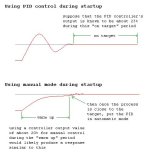Could somebody please help point me in the right direction with a small problem i've got with a basic PID control process i'm trying to commission?
I'm using a Siemens S7315-2DP processor (using the FB_41 CONT_C block) and am attempting to control the temperature of an air supply feeding into a Nitrogen generation plant. All i need to do is maintain 100 deg F (all units are imperial as per customer request) for the air temperature.
The actual temperature controlling is working absolutely fine (it deviates about 0.5 deg F, but thats more than acceptable), the problem i have is on initial start up. When the systenm is first powered up from cold, the temperature over shoots by about 20 deg F, then after approx 10 mins or so it settles down nicely to the 100 deg F sepoint temperature. I've never really had anything to do with PID and am unsure of which parameter to adjust (I've tinkered with Ti a little - but not very successfully).
This isn't a critical application, but is just annoying, as it flags up a HIGH TEMP alarm on initial start up.
Any help would be appreciated.
I'm using a Siemens S7315-2DP processor (using the FB_41 CONT_C block) and am attempting to control the temperature of an air supply feeding into a Nitrogen generation plant. All i need to do is maintain 100 deg F (all units are imperial as per customer request) for the air temperature.
The actual temperature controlling is working absolutely fine (it deviates about 0.5 deg F, but thats more than acceptable), the problem i have is on initial start up. When the systenm is first powered up from cold, the temperature over shoots by about 20 deg F, then after approx 10 mins or so it settles down nicely to the 100 deg F sepoint temperature. I've never really had anything to do with PID and am unsure of which parameter to adjust (I've tinkered with Ti a little - but not very successfully).
This isn't a critical application, but is just annoying, as it flags up a HIGH TEMP alarm on initial start up.
Any help would be appreciated.







